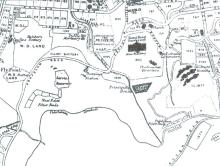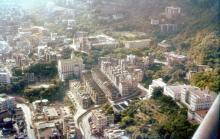Article on page 5 of the Hong Kong Telegraph, 1904-12-30:
HONGKONG MORGUE.
FIGHTING THE PLAGUE MICROBE.
The importance of maintaining a thoroughly efficient and well-equipped bacteriological institute is well recognised among the, medical profession in the East and the numerous visits of eminent medical men to Hongkong, Singapore and the Far East generally have given a stimulus to the subject. The ordinary lay member may not always see the force of these research movements especially when it is remembered that doctors themselves, almost as a matter of professional pride, are determined to disagree. However, Hongkong has so long been tormented by plague visitations that anything which promises to reveal the first symptoms in the Colony and especially to eradicate the pest will be heartily welcomed. At present the Government, or rather the Public Works Department, are engaged in the erection of a new bacteriological institute where experiments will be conducted and infected cases investigated. It will be nine months yet before the institute is ready for occupation, and in the meantime all research is being carried out at the new buildings which were recently completed at Hill Street and taken possession of practically without comment.
THE MORGUE.
In the future when the institute is occupied the buildings in Hill Street will be reserved for morgue purposes, but in the meantime all the work of Dr. Hunter, the bacteriologist in Hongkong, and his Chinese stuff, is centred there. Like all Government buildings it is plain to the point of severity. There is not a piece of ornamental work about it; the hand of the utilitarian is everywhere visible. But a short walk over the structure shows that it is admirably fitted for the purpose to which it will soon be exclusively devoted.
There are two large chambers which have been set apart as the mortuary. Each chamber has sixteen slate tables, and all the appliances necessary for such a place are installed. The windows are covered from top to bottom with a very finely-strung gauze. The walls are laid with white sanitary bricks and round the rooms is a water channel. There is not a corner, properly speaking, in the chamber, so that dirt can effect no lodgement. Besides each of the rooms is thoroughly cleansed and disinfected from top to bottom daily. The floors are of concrete, and the walks round the entire range of buildings are cemented and fitted with water channels. Indeed, the place is a model of cleanliness.
SEARCHING FOR PLAGUE SYMPTOMS.
Two of the tables, when the pressman went round the buildings the other day, were covered with dead rats of all sizes. They had been operated on with the object of finding out whether there was any infectious disease about the Colony and they lay there waiting the result. Every day in the year, special men are catching rats in every district of the city. Now and then a rat is killed in the public street and even it is sent to the mortuary. A label is attached to its tail, showing when and where it was killed and then the bacteriologist comes in. Should the slightest evidence of plague, cholera or other contagious disease appear in the heart or spleen, the place whence the rat showing these symptoms came, is disinfected outside and in. "What happens when a rat is killed in an open space, and that rat is found to be infected ?" The answer was that nothing could be done, except to keep a stricter lookout for further signs of disease in the vermin brought from houses.
DISEASE GATHERERS.
It is a canon that when disease is about to appear in the city, it first makes itself known through the medium of rats. How these rats have contracted the disease, whether they have come from infected ports like Canton, say, and managed to escape ashore, it is impossible to say. But once the disease is seen, then the authorities start in to work ; the rats of Hongkong are like railway fog signals, or weather forecasts - indeed, they are rather more reliable than the clerk of the weather as a rule. A mortuary, even if it be also a place of research, is, of course, hardly a pleasant place to view. With its dead chambers, its cellars for coffins, and so forth it forms a somewhat grisly subject. Coming to the other rooms, one is occupied with a full set, or what will be in a short time a complete outfit, of bacteriological appliances. What is at present the office where Dr. Hunter is usually engaged, is also filled with evidences of re-search, including the inevitable tubes full of living bacteria.
As already stated, the buildings are spotlessly clean, as they doubtless have to be, and have been constructed on the most modern principles. Dr. Hunter is assisted by several trained Chinese in his ordinary work, which leaves him a modicum of time for his purely scientific labours. The place is situated up a steep hill, and is entirely clear of any buildings for a considerable distance on either side. As for the new institute which is in course of construction, it will be one of the most efficient in this part of the world, but it is too early yet for a detailed account of it, only a vague idea of its proportions and appearance being as yet obtainable.



Comments
Hill Road Mortuary
This grim,red brick facility was in operation until at least 1964.It was eventually replaced by a newly built mprtuary on the then waterfront further west.
1st Generation Mortuary
There was a mortuary on this site prior to the 1904 building, it was found to be too small so an extension was built and the old building completely rebuilt.
Source (No 80)
There is a place for the original Mortuary on this site here
Mortuary, Hill Rd
As a small boy, I used to walk along Pokfulam Rd from Third St to Belcher Gardens after school each day. On my right, I could see, top down, the little house with a black roof, somewhat like the old Wanchai Post Office, which was the Hill Rd Public Mortuary. Often, there were hearses or Black Box Lorries of the USD outside loading and unloading... I turned my head to the left and there was the sight of the two-storey English-style brick building which housed the Pathology Dept of HKU. There were, clearly visible, display of body parts in glass boxes right at the windows. Inevitably, a hearse would pass by on its way to the cemeteries further down Pokfulam Rd. It was customary to release papers known as Kai Chin, from the hearse along the way to lead the spirit back home so they say. These flew to your face or you may step onto one...perhaps mislead the spirit home! At Belcher Gardens, it was said that at mid-night, one could hear the Keeper of the Tung Wah Coffin House at Smithfield Rd (now Caritas Centre) calling out loud to get the spirits to return before he locked up... I was too young to stay up that late to hear it though... Childhood trauma...
re: Mortuary, Hill Rd
Dear Lawrence,
Thanks for these memories of the area. I live near there so I always enjoy learning more about the area's history.
At the time of the Hungry Ghosts festival, there's a big, temporary opera theatre built on Hill Road, very close to the site of the old mortuary. On the one hand it is a big open space, so it is convenient to build on, but I've wondered if the choice of the site was connected with the mortuary at all.
Regards, David
80. Public Mortuary,
80. Public Mortuary, Extension and Reconstruction.—-The mortuary, which is situated in Hill Road, having been found inadequate for present requirements, it was decided to proceed with large extensions and also to take down and re-construct, in accordance with modern ideas, the old building itself. A contract for the work was let in May and, though carried on under considerable difficulties on account of the limited extent and irregular nature of the site and the use of the old building for the accommodation of the bodies of Plague victims, all the new buildings were completed by the end of the year and the reconstruction of the old mortuary was well advanced. The completed buildings will comprise two mortuaries, each of Which contains 16 tables, a rat-examination room, measuring 30 feet by 16 feet, 3 small offices, 2 small stores and accommodation for 4 coolies, the whole of the premises being enclosed by a high boundary wall. The buildings are of red brick, plastered externally and internally, except where lined with white glazed tiles, and have roofs of double pun and roll tiling, supported on timber purlins and principals. The walls of the mortuaries and rat-examination room are lined for it height of 6 feet above the floor with white glazed tiles obtained from England and the floors are laid with-glazed paving tiles of local manufacture except in the case ol the Reconstructed mortuary Where the floor is rendered with cement mortar, the tiles used in the case of the other buildings not being considered altogether satisfactory. ln addition to the ordinary outer doors, the mortuaries and rat-examination room are provided with inner doors of open construction, covered with mosquito~proof wire gauze, and all openings for windows and ventilators are similarly protected. The tables and other fittings for use in the mortuaries have been obtained from England. The whole of the compound is covered with lime concrete 4 inches thick, finished off with two inches of fine cement concrete and a special drain is provided from the buildings to the harbour, no other drains whatever being connected with it.
1903 PWD Report Source
Hill Rd Ghost Festival Opera
I would speculate that the ghost liturgies would also be connected to the explosion of the gas installation 1934 with over 40 dead and another 40 injured; as well as a big fire of the godowns of 'Kwan Yick Chong' (China Provident), also with many dead and injured. When did this happened I know not, sinceI heard story from my primary school teacher at St Louis' School nearby, that students volunteered to help the firemen put it out.
My boyhood impression was that Sai Wan (Western District) was a rather morbid neighbourhood with all the desasters, hospitals, coffin homes, morgue and cemeteries. My great grandfather first settled there when he immigrated to HK in the 1890s. Many Hakkas from his home county, Wuhua, Eastern Guangdong, settled in Sai Wan because it was place for quarrying; Hakka people predominate in the quarrying trade in HKfor a long time in the past. I guess the hillsides that were cut made good platforms for the Belcher Batteries, which eventually redeveloped into my childhood home - The Belchers Gardens Chinesse Civil Servants Co-operative Building Society. The Hakka community Kau Yan Church (Salvation Church) of the Shung Chun Wui (the local branch of the Lutheran Swiss Basel Mission which had roots in Wuhua) is also located nearby. My Great Grandfather's family were resettled from what was referred to as Fan Yee Taan (beach for laundering Western apparels?) in Western District to Telegraphic Bay (nowadays Cyberport); probably in connection with the recalmation and redevelopment of the Western waterfront of the 1900s.
Lawrence
Hill Rd Ghost Festival Opera
Hi Lawrence,
It is always great to read stories about your family and our alma mater. Have you considered writing books about them?
Regarding the big fire of the godoens, could it be the Wing On Warehouse fire on 22nd Sep. 1948? The address was 351 to 367 Des Voeux Road West, and the death toll was 176 (second only to the Racecourse fire in terms of casualties).
May I ask what the Chinese characters for 'Fan Yee Taan' are? This is a place name that I have never come across. Thank you.